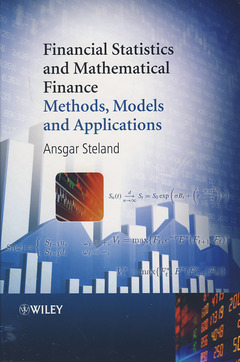Financial statistics and mathematical finance: methods, models and applications Methods, Models and Applications
Auteur : Steland Ansgar

Mathematical finance has grown into a huge area of research which requires a lot of care and a large number of sophisticated mathematical tools. Mathematically rigorous and yet accessible to advanced level practitioners and mathematicians alike, it considers various aspects of the application of statistical methods in finance and illustrates some of the many ways that statistical tools are used in financial applications.
Financial Statistics and Mathematical Finance:
- Provides an introduction to the basics of financial statistics and mathematical finance.
- Explains the use and importance of statistical methods in econometrics and financial engineering.
- Illustrates the importance of derivatives and calculus to aid understanding in methods and results.
- Looks at advanced topics such as martingale theory, stochastic processes and stochastic integration.
- Features examples throughout to illustrate applications in mathematical and statistical finance.
- Is supported by an accompanying website featuring R code and data sets.
Financial Statistics and Mathematical Finance introduces the financial methodology and the relevant mathematical tools in a style that is both mathematically rigorous and yet accessible to advanced level practitioners and mathematicians alike, both graduate students and researchers in statistics, finance, econometrics and business administration will benefit from this book.
1 Elementary Financial Calculus 1
1.1 Motivating Examples 1
1.2 Cashflows, interest rates, prices and returns 2
1.2.1 Bonds and the term structure of interest rates 5
1.2.2 Asset returns 6
1.2.3 Some basic models for asset prices 7
1.3 Elementary statistical analysis of returns 11
1.3.1 Measuring location 13
1.3.2 Measuring dispersion and risk 15
1.3.3 Measuring skewness and kurtosis 19
1.3.4 Estimation of the distribution 20
1.3.5 Testing for normality 26
1.4 Financial instruments 28
1.4.1 Contingent claims 28
1.4.2 Spot contracts and forwards 28
1.4.3 Futures contracts 29
1.4.4 Options 29
1.4.5 Barrier Options 30
1.4.6 Financial engineering 31
1.5 A Primer on Option Pricing 32
1.5.1 The no-arbitrage principle 32
1.5.2 Risk-neutral evaluation 33
1.5.3 Hedging and replication 35
1.5.4 Non-existence of a risk-neutral measure 36
1.5.5 The Black-Scholes pricing formula 36
1.5.6 The Greeks 38
1.5.7 Calibration, implied volatility and the smile 40
1.5.8 Option prices and the risk-neutral density 41
1.6 Notes and further reading 42
References 43
2 Arbitrage Theory for the One-Period Model 45
2.1 Definitions and preliminaries 45
2.2 Linear pricing measures 47
2.3 More on arbitrage 50
2.4 Separation theorems in Rn 52
2.5 No-arbitrage and martingale measures 55
2.6 Arbitrage-free pricing of contingent claims 63
2.7 Construction of MartingaleMeasures: General Case 68
2.8 Complete financial markets 71
2.9 Notes and further reading 74
References 74
3 Financial Models in Discrete Time 75
3.1 Adapted stochastic processes in discrete time 77
3.2 Martingales and martingale differences 81
3.2.1 The martingale transformation 87
3.2.2 Stopping times, optional sampling and a maximal inequality 88
3.2.3 Extensions to Rd 97
3.3 Stationarity 97
3.3.1 Weak and strict stationarity 98
3.4 Linear Processes and ARMA Models 106
3.4.1 Linear processes and the lag operator 106
3.4.2 Inversion 111
3.4.3 AR(p) and AR() processes 113
3.4.4 ARMA processes 117
3.5 The frequency domain 118
3.5.1 The spectrum 118
3.5.2 The periodogram 121
3.6 Estimation of ARMA processes 126
3.7 (G)ARCH models 127
3.8 Long memory series 133
3.8.1 Fractional differences 133
3.8.2 Fractionally integrated processes 137
3.9 Notes and further reading 137
References 138
4 Arbitrage Theory for the Multi-Period Model 139
4.1 Definitions and preliminaries 139
4.2 Self-financing trading strategies 140
4.3 No-arbitrage and martingale measures 143
4.4 European claims on arbitrage-free markets 146
4.5 The martingale representation theorem in discrete time 150
4.6 The Cox-Ross-Rubinstein binomial model 151
4.7 The Black-Scholes formula 156
4.8 American options and contingent claims 161
4.8.1 Arbitrage-free pricing and the optimal exercise strategy 161
4.8.2 Pricing American options using binomial trees 164
4.9 Notes and further reading 165
References 166
5 Brownian Motion and Related Processes in Continuous Time 167
5.1 Preliminaries 167
5.2 Brownian Motion 170
5.2.1 Definition and basic properties 170
5.2.2 Brownian motion and...
Ansgar Steland, Institute for Statistics and Economics, RWTH Aachen University, Germany.
Date de parution : 08-2012
Ouvrage de 352 p.
17.8x25.4 cm
Disponible chez l'éditeur (délai d'approvisionnement : 12 jours).
Prix indicatif 89,57 €
Ajouter au panierThème de Financial statistics and mathematical finance: methods... :
Mots-clés :
Financial Statistics and Mathematical Finance, martingale theory, stochastic processes, stochastic integration, arbitrage theory for the one-period model, financial models in discrete time, abitrage theory for the multi-period model, brownian motion, Levy processes, Black-Scholes Model, limit theory for discrete-time processes


